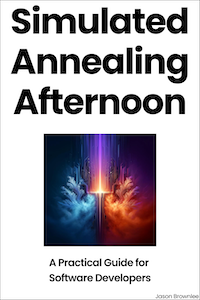Simulated Annealing Afternoon #
Simulated Annealing Afternoon: A Practical Guide for Software Developers
A mini-book dedicated to the simulated annealing.

Table of Contents #
- Introduction
- Chapter 1: Introduction to Simulated Annealing
- Chapter 2: Temperature and Cooling Schedules
- Chapter 3: Generating Solutions and Acceptance Criteria
- Chapter 4: Integrating Components into the Algorithm
- Chapter 5: Analyzing and Refining the Algorithm
- Conclusions
Praise #
“Simulated Annealing Afternoon” is an Amazon Best Seller:

Synopsis #
Are you a software developer looking to harness the power of simulated annealing to solve complex optimization problems? “Simulated Annealing Afternoon: A Practical Guide for Software Developers” is your go-to resource for mastering this innovative and powerful technique. Whether you’re a beginner or an experienced programmer, this book will guide you through the fundamental concepts and practical applications of simulated annealing, empowering you to enhance the efficiency and performance of your software projects.
What You’ll Learn #
In this hands-on guide, you’ll discover how to:
- Understand the core concepts and terminology of simulated annealing
- Grasp the physical inspiration behind the algorithm and its role in optimization
- Implement temperature functions and cooling schedules to control the annealing process
- Generate neighboring solutions and apply acceptance criteria to explore the solution space effectively
- Integrate the components of simulated annealing into a complete, functional algorithm
- Analyze and refine your simulated annealing algorithm for optimal performance
- Apply simulated annealing to real-world optimization problems in software development
Key Features #
- Clear, concise explanations of simulated annealing concepts and their practical applications
- Python code examples and exercises to reinforce your learning and facilitate hands-on experience
- Engaging descriptions and visualizations to aid in understanding the algorithm’s behavior
- Accessible content suitable for software developers of all skill levels
Table of Contents #
Chapter 1: Introduction to Simulated Annealing: Dive into the world of simulated annealing, exploring its origins in statistical mechanics and its application to optimization problems. Grasp the basic concepts, terminology, and pseudocode of the algorithm, and choose a suitable test problem to work with throughout the book.
Chapter 2: Temperature and Cooling Schedules: Discover the crucial role of temperature in simulated annealing and learn how to implement effective cooling schedules. Explore different types of cooling schedules and their impact on the algorithm’s performance, and practice implementing temperature functions in Python.
Chapter 3: Generating Solutions and Acceptance Criteria: Learn how to generate neighboring solutions and apply acceptance criteria to navigate the solution space effectively. Understand the acceptance probability function and its role in balancing exploration and exploitation, and compare and contrast simulated annealing with other optimization techniques.
Chapter 4: Integrating Components into the Algorithm: Put your knowledge into practice by integrating the key components of simulated annealing into a complete, functional algorithm. Follow a step-by-step implementation guide, and learn how to debug and test your code to ensure its correctness and efficiency.
Chapter 5: Analyzing and Refining the Algorithm: Take your simulated annealing skills to the next level by learning how to analyze and refine your algorithm for optimal performance. Explore performance metrics, parameter tuning techniques, and data visualization methods to gain insights into your algorithm’s behavior, and discover strategies for continuous improvement.
Whether you’re looking to optimize your software projects, tackle complex computational problems, or expand your algorithmic toolbox, “Simulated Annealing Afternoon: A Practical Guide for Software Developers” is your essential companion. Embark on a journey of discovery and unlock the potential of simulated annealing today!